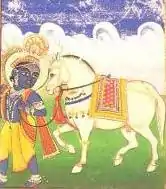Satya Yuga
The Satya Yuga (Sanskrit: सत्ययुग, romanized: satyayuga, lit. 'age of truth'), a.k.a. Sat Yuga or Krita Yuga (Sanskrit: कृतयुग, romanized: kṛtayuga or kṛta-yuga, lit. 'age of piety'), in Hinduism, is the first of the four yugas, and is known as the age (era) of Truth, when humanity is governed by gods, and every manifestation or work is close to the purest ideal and humanity will allow intrinsic goodness to rule supreme. It is sometimes referred to as the "Golden Age". The Satya Yuga lasts 1,728,000 years or 4800 divine years. The god Dharma (depicted in the form of a bull), which symbolises morality, stood on all four legs during this period. Later on in the Treta Yuga, it would become three, followed by two in the Dvapara Yuga. Currently, in the immoral age of Kali, it stands on one leg.
The cycle
The yugas are said to succeed each other almost endlessly. After the perfect Satya Yuga, a decline marks the Treta Yuga. Further decline brings about the Dvapara Yuga, and after it comes the final and dark Kali Yuga, a time of wickedness, when people kill each other. At the end of the Yuga Cycle, Kalki is said to take birth and reestablish righteousness, thus beginning a new Satya Yuga, or yuga of truth.
The Satya Yuga according to some holy texts
As described in the Mahabharata, a Hindu epic:
there were no poor and no rich; there was no need to labor, because all that men required was obtained by the power of will; the chief virtue was the abandonment of all worldly desires. The Krita Yuga was without disease; there was no lessening with the years; there was no hatred or vanity, or evil thought; no sorrow, no fear. All mankind could attain to supreme blessedness.
Brief Explanation
Among the four eras, the Satya Yuga is the first and the most significant one. Knowledge, meditation, and penance hold special importance in this era.[1] All the pillars of dharma are present in totality. During Satya Yuga, all people engage only in good, sublime deeds. Ashrams become devoid of wickedness and deceit. Natyam (classical dance), according to Natya Shastra, did not exist in the Satya Yuga "because it was the time when all people were happy". This yuga extends up to 1,728,000 years. Lord Vishnu incarnated in four forms i.e. Matsya, Kurma, Varaha and Narsimha in this era. The only text which was considered credible and was followed was Manu’s Dharma Shastra. The average human lifespan in Satya Yuga began with 100,000 years and gradually decreased to 10,000 years.
One shall witness the total establishment of Sanatan Dharma (eternal religion). All the deities, demons, Gandharvas, and Yaksha would give up their hatred and differences. The Rigveda, Samaveda and Yajurveda were not separate and demarcated. This era was devoid of agricultural activities or any other type of activity. Just by mere contemplation one would beget desired results. People in this era would never fall ill. No one would try to point out faults or demerits in anyone’s personality. The personality was not plagued by demerits like ego, sorrow, violent thought (aggression), jealousy, hatred, backbiting, fear, anger and lethargy.
At that time, the color of the Supreme cosmic soul that was situated in the heart of one and all and the savior of all the sages was white (light).
All the people that are Brahmins, Kshatriyas, Vaishyas and Shudras were embellished with all the good qualities. People would practice austerities and penance to attain Brahman. All would be inclined towards the supreme knowledge and all actions performed would be in the intention of attaining celestial bliss.
In this way all these divine people would be bestowed with sublime faith and piousness. Albeit, people were segregated on the basis of the varnashram method, they would all response their faith in the Vedas and the Sanatan Dharma because these people were devoid of selfishness, and they would effortlessly attain sublimity or union with God, which is a salient feature of Satya Yuga. Very valiant, mighty, intelligent and people gifted with all good qualities would be born in this era. They would surprisingly give birth to thousands of children. Great sages embellished with divinity would be born in this era.
End of Kali Yuga and starting of Satya Yuga
The tenth avatar of the Lord Vishnu in the current Yuga Cycle is foretold to appear at the end of Kali Yuga, the current epoch. The Puranas foretell that Kalki will be atop a white horse with a drawn blazing sword. He is the harbinger of the end time in Hindu eschatology, after which he will usher in Satya Yuga.
Astrology
Kalki can only be the one whose tithi (birthday) falls on Dwadashi of shukla pakshya. This amounts to just 12 days per any given year; furthermore, as it can only be the day of the Lord Sri Maha Vishnu (Chaitra Dwadashi), this amounts to just one day each year or 100 days in the last century.
Indian astrologers have analysed Puranas extensively to try to foretell the time of Kalki's birth. The signs described in the Kalki Purana are as follows:
- The moon will be in Dhanishtha nakshatra, Aquarius, suggesting he will be wealthy, acclaimed and swift in action and thought.
- The sun will be in Swati, the nakshatra of the sword.
- Jupiter will be in Purva Ashadha nakshatra (Sagittarius).
- The Ascendant Lord will be in Purva Ashadha nakshatra, suggesting invincibility and early victory.
- Saturn will be exalted in Libra, predicting a balance between justice and the sword.
- Ketu, a half snake (upper part of body) and half human (lower part of body) demon in navagraha, will be exalted in Scorpio, suggesting he will descend atop a great white steed.

The Puranas describe the date as twenty-one fortnights from the birth of Krishna, which itself falls on Janmashtami in August. This would put his descent at Vaishakha, between April and May. At this time, the father of Kalki is foretold to be overwhelmed by the incarnation of Godhead that he sees as his son. This places Kalki under the sun sign of Aries or Taurus.
The Bhavishya Purana foretells:
The Savior of the entire universe, Maha Vishnu
will be born on Margashirsha Month, Krishna Ashtami
8th day after the full-moon day.— Bhavishya Purana, Canto IV, Chapter 23, Text 15
There have been a range of dates predicted, purportedly from different methods of calculation.[2][3] Sri Potuluri Virabrahmendra Swami, for example, wrote 400 years ago in his Divya Maha Kalagnanam,[4] or 'Divine Knowledge of the Time,' that Kalki would arrive when the moon, sun, Venus and Jupiter entered the same sign. This is not a rare occurrence and last happened in early 2012, passing without event.[5] The time of Kalki's arrival has not been consistently asserted by astrologers.[3]
See also
References
- Raghunath Ghosh (2008). Humanity, Truth, and Freedom: Essays in Modern Indian. Northern Book. p. 81. ISBN 978-81-7211-233-2.
- "Archived copy". Archived from the original on 7 August 2017. Retrieved 6 August 2017.CS1 maint: archived copy as title (link)
- Chandra, Suresh (15 August 2012). Encyclopaedia of Hindu Gods and Goddesses. Kindle Edition.
- http://www.kalagnanam.in/
- Santanu Acharya. "Hindu Prophecies: Translations from the Kalki Purana". Ww-iii.tripod.com. Retrieved 20 January 2013.
